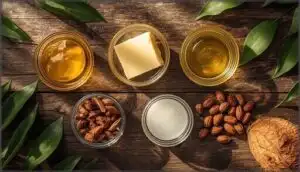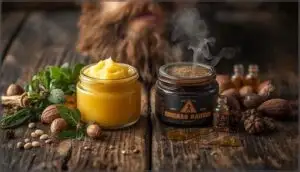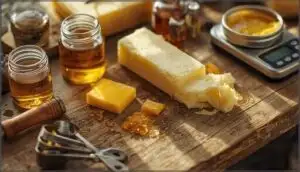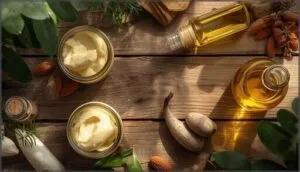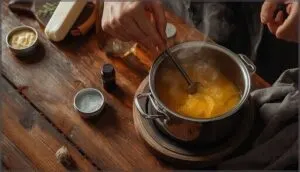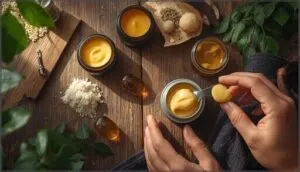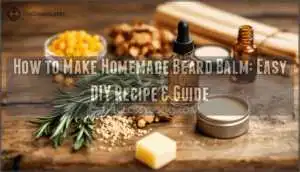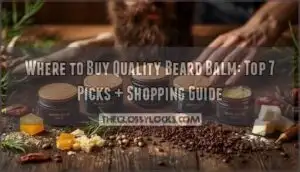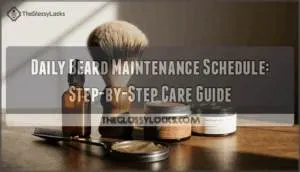This site is supported by our readers. We may earn a commission, at no cost to you, if you purchase through links.
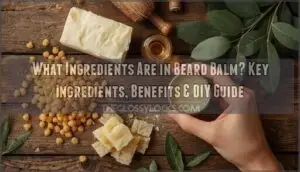
The best balms rely on natural powerhouses like beeswax for hold, nourishing butters for moisture, and carrier oils that actually absorb into your skin and hair. But not all ingredients are created equal, and some can do more harm than good. Understanding what goes into your balm helps you pick products that work with your beard, not against it.
Table Of Contents
- Key Takeaways
- Essential Ingredients in Beard Balm
- Functions and Benefits of Each Ingredient
- Harmful Ingredients to Avoid
- Top 8 Beard Balm Ingredient Products
- 1. YQ Fizz Silver Metal Tins
- 2. Beesworks Yellow Beeswax Bars Cosmetic Grade
- 3. Texas Beeswax for Candle and Skin
- 4. Better Shea Butter Raw Shea Butter
- 5. Okay Yellow Shea Butter Moisturizer
- 6. Mary Tylor Naturals Shea Butter
- 7. Cliganic Organic Jojoba Oil For Skin
- 8. Gentlemen’s Fragrance Oils for Diffusers Set
- Customizing and Making Your Own Beard Balm
- Frequently Asked Questions (FAQs)
- Conclusion
Key Takeaways
- The best beard balms use natural ingredients like beeswax for hold, nourishing butters for moisture, and carrier oils that deeply hydrate without feeling greasy.
- Harmful additives such as petroleum jelly, sulfates, synthetic fragrances, and drying alcohols can irritate your skin and damage beard health, so they’re best avoided.
- Key ingredients like shea and cocoa butter, jojoba and argan oil, and essential oils not only moisturize and strengthen your beard but also soothe skin and fight beard itch.
- Choosing the right blend and ratio of these ingredients lets you customize texture, scent, and performance for a softer, healthier, and more manageable beard.
Essential Ingredients in Beard Balm
Regarding beard balm, a few core ingredients make all the difference. Each one plays a key role in how your beard looks and feels.
Here’s a quick look at the essentials behind a good balm.
Beeswax for Hold and Shape
Beeswax is the backbone of beard balm styling—think of it as your balm’s steering wheel. Use beeswax ratios to dial in hold duration, from subtle control all the way to a waxier balm that tames wild hair for up to eight hours.
It’s a key beard balm ingredient, locking in shape, supporting environmental protection, skin conditioning, and even fragrance retention. Many beard balms, such as this beeswax balm, also condition and soften facial hair.
Butters for Moisture (Shea, Cocoa, Mango)
Let’s talk about butters, the workhorses of beard balm moisturizing. Shea, cocoa, and mango—butters each bring a different texture and absorption rate. Shea butter is the dryness assassin, while cocoa adds body and mango soaks in fast. Cocoa butter also contains vitamin E for healthy skin.
Pro tip: DIY butter recipes often use a 25–33% blend ratio for that perfect skin-moisturizing, soft-yet-tacky feel. Butter sourcing practices matter, too.
Carrier Oils for Conditioning (Jojoba, Argan, Coconut)
After butters soak in, carrier oils take center stage—think of them as your beard’s daily pick-me-up. Fast-absorbing oils like jojoba, argan, and coconut deliver:
- Deep hydration minus the greasiness
- Fatty acid benefits for hair strength
- Non-comedogenic properties for clear skin
- UV protection from daily stress
- Excellent blend performance for lasting softness
Essential Oils for Scent and Nutrients
While carrier oils handle deep hydration, essential oils steal the show with scent and an oil nutrient profile that brings more than just fragrance to your beard.
Think tea tree for antimicrobial benefits, sandalwood for a favorite scent profile, and regionally sourced organic essential oils for purity.
Keep safety concentrations in mind, and blend to personal scent preferences for a truly custom experience.
Functions and Benefits of Each Ingredient
Every ingredient in your beard balm has a purpose, working together to keep both hair and skin in top shape. Each one brings a specific benefit, from adding moisture to taming texture.
Here’s what you can expect from the core ingredients in your balm.
Moisturizing Dry Skin and Hair
Dry skin and a scratchy beard don’t have to be your daily reality. Balm benefits go way beyond styling—they deliver serious skin hydration and texture enhancement.
Studies show that shea butter and cocoa butter reduce moisture loss by 48%, while jojoba and argan oils boost skin moisturizing by 52%.
The result? Noncomedogenic hydration that lasts up to eight hours, with anti-inflammatory perks and skin protection that cut beard itch by 43%.
Promoting Beard Growth and Strength
You want a beard that grows thick and strong, not one that stalls out or breaks off. Beard balm ingredients can genuinely move the needle on beard growth and hair follicles:
- Biotin Benefits — Increases hair thickness by up to 20% and boosts keratin production for stronger strands
- DHT Influence — Higher DHT levels correlate with denser, fuller beards
- Topical Peptides — Copper peptides stimulate new growth with visible improvements after three months
- Minoxidil Efficacy — Applied twice daily, it increases facial hair density by 30% within 16 weeks
Sleep deprivation cuts growth by 19%, so rest matters too.
Reducing Itch, Beardruff, and Irritation
Nearly every guy growing a beard faces itch, beardruff, or irritation, especially in those first few weeks. Beard balm confronts these issues head-on through ingredients that boost skin hydration, barrier restoration, and inflammation reduction.
| Ingredient | Primary Action | Efficacy |
|---|---|---|
| Aloe Vera | Antiinflammatory relief | Cuts redness 50% in 2 weeks |
| Jojoba Oil | Mimics sebum for dry skin | Drops sensitivity 25-30% |
| Tea Tree Oil | Antifungal Agents against beardruff | MIC 0.25–1 mg/mL |
| Shea Butter | Locks moisture, soothes sensitive skin | TEWL reduction up to 50% |
| Chamomile | Antimicrobial Efficacy, calms irritation | Lowers redness 45% |
Humectants like glycerin pull water into your skin, while emollients seal it in—relieving that maddening beard itch within days.
Improving Beard Texture and Manageability
Want softer, more cooperative whiskers? Beard balm ingredients work together to improve hair texture through cuticle smoothing and hydration importance—shea butter and jojoba oil deliver softness enhancement while beeswax handles taming flyaways and texture control.
Here’s what you’ll notice:
- Reduced breakage from strengthening follicles with vitamin E
- Sleeker appearance through moisture-sealing beard styling
- Less frizz as oils neutralize static for improving balm texture
Harmful Ingredients to Avoid
Not all beard balms are created equal, and some ingredients can actually work against you. The right stuff nourishes your beard and skin, but certain chemicals create barriers, strip moisture, or irritate your face.
Let’s look at the troublemakers you’ll want to steer clear of when choosing or making your balm.
Petroleum Jelly and Mineral Oil
Petroleum jelly and mineral oil might give your beard a shiny look, but they’re the grooming equivalent of fake news. These synthetic oils create a moisture barrier that clogs pores and traps dirt, leading to acne under your beard.
Worse, unrefined versions carry carcinogenic effects. They don’t nourish anything—just interfere with better products.
For best skin health, steer clear of these low-quality beard balm ingredients.
Sulfates and Harsh Detergents
Sulfates like sodium lauryl sulfate are harsh chemicals that strip your beard’s natural oils, leaving it dry and brittle. They cause moisture stripping that leads to irritation and flaking.
Avoiding harmful ingredients like these detergents prevents hair breakage and beardruff aggravation.
Look for mild cleansers or sulfate alternatives instead—your skin and beard will thank you. Skip the artificial fragrances and dyes too.
Synthetic Fragrances and Alcohols
Synthetic fragrances and harsh chemicals can trigger skin irritation and allergic reactions, especially on sensitive skin beneath your beard. Fragrance buildup prevents beneficial ingredients from absorbing properly. Drying alcohols like isopropyl alcohol worsen the problem by stripping moisture.
Look for safer alternatives—natural essential oils like lavender or tea tree provide pleasant scents without the nasty side effects artificial fragrances bring.
Top 8 Beard Balm Ingredient Products
Now that you know what to avoid, let’s talk about what you should actually grab.
I’ve rounded up eight solid products that’ll help you whip up a quality beard balm at home. These are the essentials that’ll set you up for success, from the container to the carrier oils.
1. YQ Fizz Silver Metal Tins
You need something to store your homemade beard balm ingredients, and these 3 oz YQ Fizz Silver Metal Tins deliver. The aluminum tin material offers protective qualities that shield your balm from UV light and moisture—essential for preserving those beard balm ingredients like types of butters, types of oils, and types of waxes.
With a 75% recycling rate, their environmental impact beats plastic hands down. Common sizes range from 5 ml to 50 ml, but these 3 oz containers give you perfect storage space without taking over your bathroom counter.
2. Beesworks Yellow Beeswax Bars Cosmetic Grade
Once you’ve got your tins sorted, you’ll need the backbone of any DIY beard balm: beeswax. Beesworks Yellow Beeswax Bars deliver 100% pure, cosmetic-grade wax that melts fast and measures easily.
At $6.99 for six 1 oz bars, you’re getting triple-filtered beeswax rich in vitamin A—no additives or chemicals. This purity matters when you’re crafting ingredients in beard balm that’ll sit on your face daily.
The subtle fragrance won’t clash with your chosen oils, and it’s adaptable enough for candles, lotions, or lip balms beyond beard balm composition.
3. Texas Beeswax for Candle and Skin
If you want locally sourced Texas beeswax that aids small-scale beekeepers, Better Shea Butter’s 1 lb bar brings raw authenticity to your beard balm ingredients. At around $11, you’re tapping into Texas’s third-ranked national honey production—126,000 colonies strong—and beeswax composition that’s roughly 71% esters and 15% hydrocarbons.
That natural structure provides dermatological applications like barrier protection and low-irritant hydration, perfect for sensitive skin. Triple-filtered and honey-scented, it’s adaptable enough for candle applications too, though cutting this dense bar takes effort.
4. Better Shea Butter Raw Shea Butter
Better Shea Butter’s raw shea butter brings ethical sourcing to your beard balm ingredients—it’s 100% unrefined from a women’s cooperative in Ghana.
You’re getting natural skin barrier protection from fatty acids like oleic (46.4%) and stearic (41.5%) that lock in moisture without clogging pores.
The 8-ounce block works beautifully in DIY applications, though product variations in color (ivory to greenish-gray) reflect its authentic, unprocessed nature.
Perfect for butters in your homemade balm, it delivers serious skin benefits while supporting sustainable practices.
5. Okay Yellow Shea Butter Moisturizer
Okay’s yellow shea butter moisturizer stands out among beard balm ingredients with its West African roots—specifically Ghana, where traditional water-boiling methods preserve natural goodness.
You’re getting unrefined shea butter rich in vitamins A, E, and F that clinical studies show improves skin hydration by up to 30% within four weeks. The yellow color comes from natural Borututu root, not artificial dyes.
Just know it has a distinct smell and may contain plant specks, but those “imperfections” prove you’re working with authentic, minimally-processed skin care that delivers real moisturizing results.
6. Mary Tylor Naturals Shea Butter
Mary Tylor Naturals delivers USDA Certified Organic shea butter straight from Ghana—raw, unrefined, and packed with vitamins A and E that research shows boost skin hydration by protecting your moisture barrier.
You’re getting Grade A shea butter extracted through traditional methods that preserve anti-inflammatory properties proven to calm irritated skin and reduce beardruff. The ivory color and nutty aroma confirm minimal processing, though some batches carry a stronger earthy scent.
It’s authentic beard balm ingredients without synthetic additives, supporting fair trade sourcing practices while moisturizing your whiskers naturally.
7. Cliganic Organic Jojoba Oil For Skin
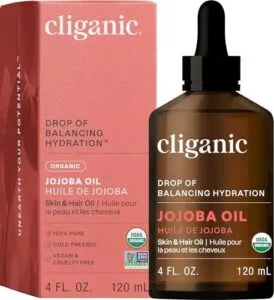
Cliganic Organic Jojoba Oil mirrors your skin’s natural sebum, which is why it absorbs fast without clogging pores. This USDA-certified carrier oil delivers skin hydration through cold-pressed purity, reducing excess oil by 25% while boosting radiance up to 24%.
You’re getting organic jojoba benefits backed by consumer validation: softer whiskers, healthier skin, and zero synthetic additives.
Apply 2-4 drops to damp facial hair for natural ingredients that tame frizz and lock in moisture. It’s lightweight skin and hair moisturizing that actually works.
8. Gentlemen’s Fragrance Oils for Diffusers Set
P&J Trading’s Gentlemen’s set brings masculine scent profiles like sandalwood oil, cedarwood, and vanilla straight to your DIY diffuser blends—and your beard balm recipe. These IFRA-certified essential oils deliver the woody, spicy notes that match consumer scent preferences without synthetic junk.
You’ll get fragrance oil longevity that outlasts natural extracts, plus diffuser oil safety standards that matter when you’re working near your face. Use 3-5 drops per batch to customize your balm’s scent profiles, from fresh bay rum to warm tobacco leather.
Customizing and Making Your Own Beard Balm
Making your own beard balm puts you in the driver’s seat regarding what goes on your face. You’ll control everything from the texture and hold to the scent and skin benefits.
Here’s how to craft a custom balm that works exactly the way you want it to.
Choosing Ingredient Ratios for Desired Consistency
Think of balancing wax ratios like tuning an engine—small tweaks make all the difference. For a firm hold, aim for a 20-25% beeswax percentage with your carrier oils. If you want something softer that melts easily, drop it to 11-16%.
Butter blends work best at 30% total, mixing shea butter with cocoa for creaminess.
Climate influence matters too—warmer weather needs less wax to prevent melting.
Selecting Oils and Butters for Skin Needs
Your skin type drives which oils and butters work best. Jojoba and argan oil won’t clog pores—perfect for acne-prone beards—while shea butter sits low on comedogenic scales for sensitive skin types. Sweet almond oil absorbs quickly, and cocoa butter locks in moisture longer.
Ingredient synergy matters: pairing fast-absorbing carrier oils with richer butters gives you both instant conditioning and lasting protection.
Step-by-Step DIY Beard Balm Instructions
Once you’ve picked your oils and butters, here’s your beard balm recipe. Use a double boiler for even melting techniques—melt 28 grams of beeswax with 28 grams of shea butter and 28 grams of jojoba oil over low heat. Stir constantly.
Remove from heat, add 8-10 drops of essential oils for scent blending, then pour into metal tins. Let it cool at room temperature—no fridge—for smooth consistency adjustments in your homemade beard balm.
Storing and Applying Homemade Beard Balm
Your homemade beard balm storage matters—keep it in a cool, dry spot away from sunlight for 12 to 24 months of balm shelf life. Metal tins or amber glass jars work best as container types.
For application methods, warm a pea-sized amount between your palms, then work it from roots to tips. Watch for degradation signs like rancid smells or color changes to maintain balm longevity.
Frequently Asked Questions (FAQs)
Can beard balm expire or go bad?
Your beard balm won’t last forever, yet proper care extends its usefulness. Yes, it can expire—oxidation process degrades carrier oils over time.
Watch for rancidity signs like off-smells or texture changes indicating chemical changes in ingredient quality.
Is beard balm safe for sensitive skin?
Yes, but choose carefully. Those with sensitive skin should pick fragrance-free, hypoallergenic formulas.
Patch testing helps avoid irritation from allergens like essential oils or nut butters, reducing reactions by up to 70%.
Whats the difference between balm and oil?
Oil hydrates skin and softens facial hair, while beard balm vs beard oil shows balm adds hold versus hydration with ingredient density.
Application techniques vary by beard length, and environmental protection is provided by styling wax.
How much beard balm should I use daily?
Oh, wouldn’t it be nice if there were a one-size-fits-all answer? Beard balm application really depends on beard length, your beard texture, and climate impact.
For a daily beard care routine, start small—avoid balm overuse for easy styling and moisturization.
Can women use beard balm products too?
Absolutely—women use beard balm, too. Its natural ingredients offer skin benefits, tame hair frizz, soothe sensitive skin, and suit scent preferences.
With the market seeing strong female usage and fragrance-free options, ingredient safety and irritation prevention matter most.
Conclusion
Think of your beard as a garden, and the ingredients in beard balm are the soil it grows from. When you choose nurturing oils, rich butters, and natural scents, you’re planting seeds that yield a softer, healthier, more manageable beard every day.
The wrong “soil”—harsh chemicals or fillers—won’t just stunt growth; it can leave things barren. So, trust what goes in, and your beard will reward you with thick, strong roots and vibrant life.
- https://shopbryanthill.com/blogs/news/beeswax-vs-soy-wax-for-beard-balm-the-positives-and-negatives-of-each
- https://www.wild-willies.com/a/blog/the-best-beard-wax-and-balm-5-brands-to-choose-from
- https://www.vedaoils.com/blogs/news/diy-beard-butter
- https://hbno.com/blogs/news/best-carrier-oils-for-beard-growth-thickness-beard-balm
- https://www.doctornicks.com/blogs/news/beard-balm-vs-beard-butter

